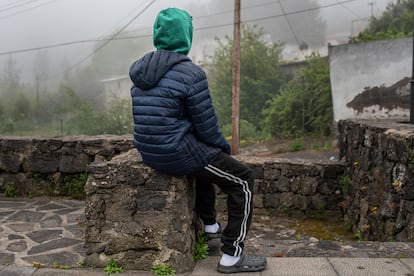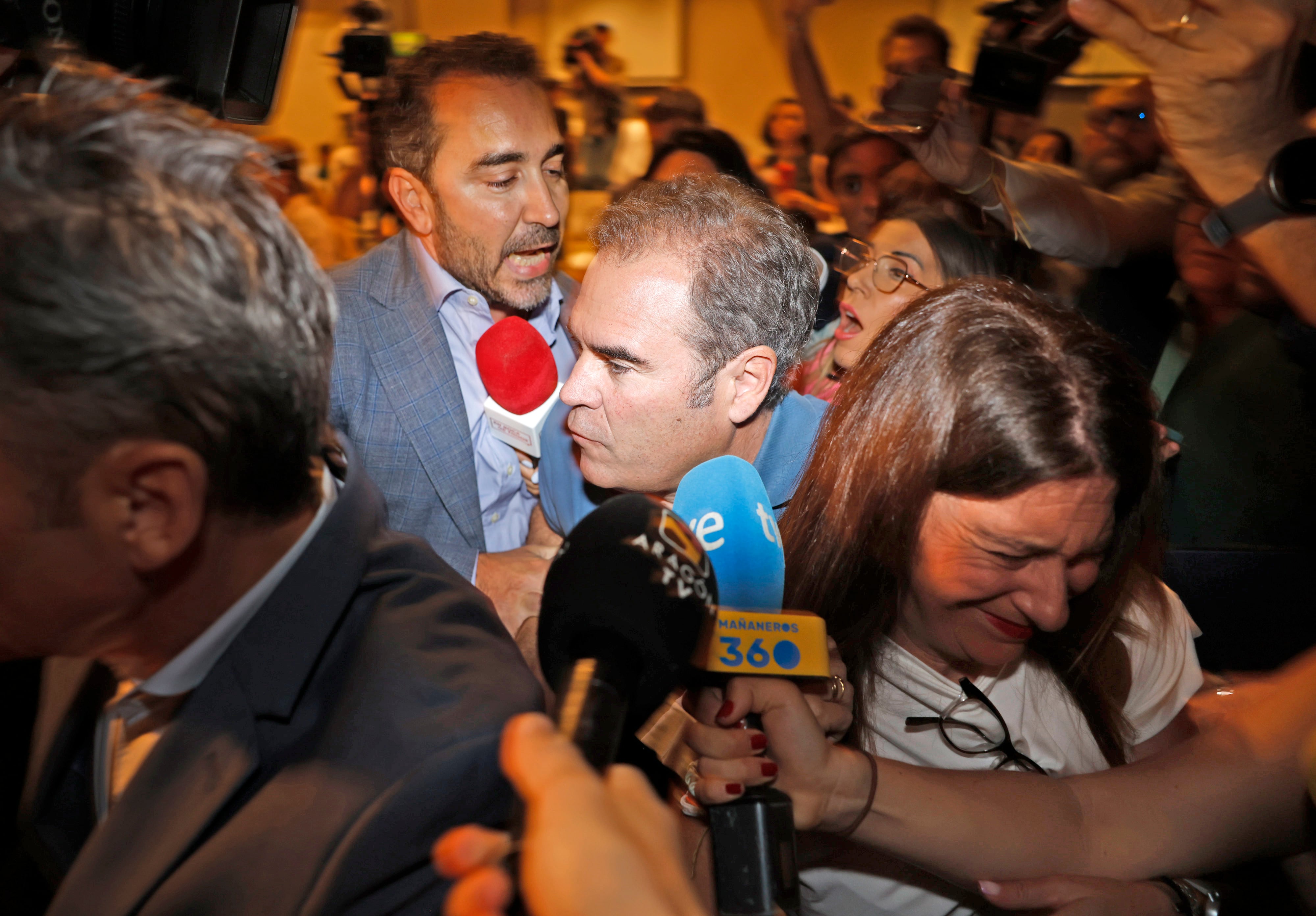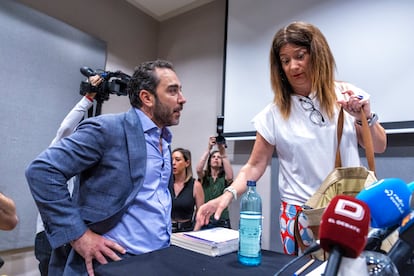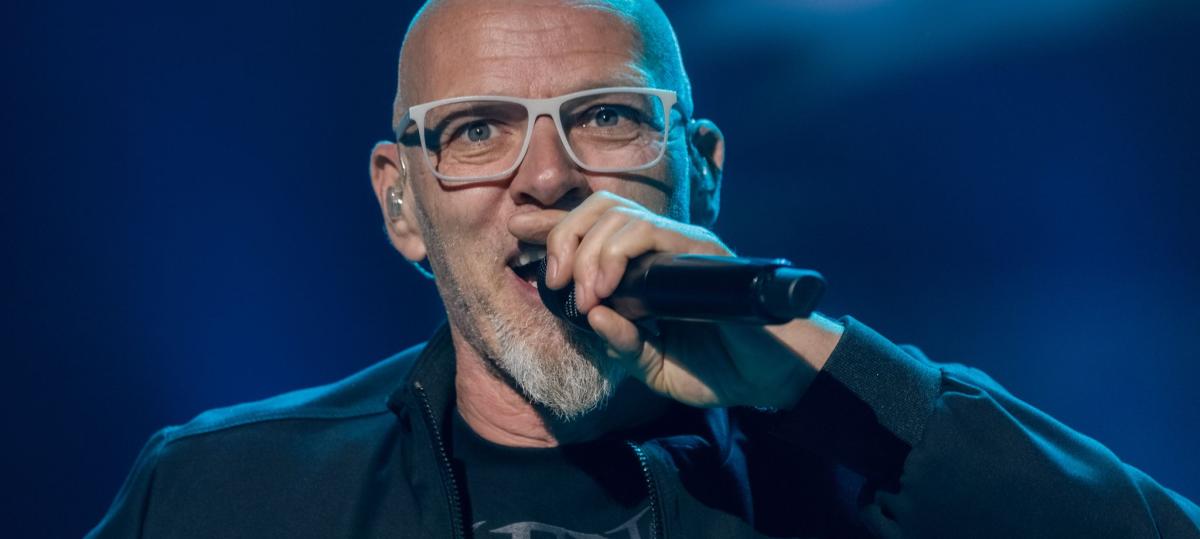The deadly trap of the Cayuco that was shipwrecked in the Restinga: women and children, trapped in wooden ‘cages’ | Spain
After 9.30 in the morning of May 28, a wooden cayuco, with a Barça shield painted in the bow, entered the port of La Restinga towed by a maritime rescue ship. Two weeks ago a boat did not arrive at El Hierro Island, the sun shone and the sea was calm. On board, 152 people, including 45 women and 29 children celebrated being safe. In a matter of minutes, the boat overturned. Four women and three girls died.
The images that emitted that day all the news show how the ship swallows many people who does not even get the head to the surface because they were trapped inside the ship. They would have been many more victims of not having been for passengers like Ibrahima, a 29 -year -old mechanic, from Mbour (Senegal).
Early in a green jersey with a open hood to the eyes, the young man acts as a spokesman for other Senegalese outside the Tenerife immigrants camp where they have moved them. Ask that your real name is not published. « A group of women and children got caught when the Cayuco turned around. We started diving below the ship: we got to them, we took them out and delivered them. Again and again, » he recalls. He says that, fortunately, an air bubble had been created under the boat. « I don’t know how many people we got. They were enough. »
The ship itself ended up being a deadly trap. The Cayuco that was shipwrecked in the same port was not like the ones that usually arrive in the Canary Islands: he hid inside at least three wooden compartments in which women and children traveled overwhelmed, a group that in this boat was more numerous than usual. « There were entire families inside, » recalls one of the survivors, a 26 -year -old guinean young. The same structure that protected them from the wind, waves and cold during a five -day trip through the ocean became a cage during The agonized resolution broadcast live on Televisión Canaria.
« They put women and children there, » Aicha emphasized, a Guinean, who asks that his real name be published. « But it wasn’t safe, it wasn’t safe! » He exclaims. This mother of two children knew they had arrived because she heard the shouts of happiness that came from the roof and hastened to leave. « I stood up in the middle of many people. I felt a lot of fear of falling into the water, but I swam and threw me a lifeguard. »
The event is a new tragedy in one of the most dangerous migratory routes in the world in which thousands of people die every year who found no more safe way to emigrate to Europe. But this shipwreck – the third that occurs in the last year while the rescue occurs – also raises questions about how to adapt the rescue protocols and the means to this type of emergencies.
The seven deceased, As read in a 5W magazine chroniclethey were buried in different cemeteries of El Hierro just two days after the event. The relatives who were traveling with some of them could go to the burials – something unusual because they were still in police custody – and a handful of neighbors of the island. « They lost when they were about to win. And it was broadcast live, » writes the photojournalist Anna Surinyach.
They were called Fatoumatta Banaro, Mariama, Sarah Samoura, Mami Kamara, Adama Keita, Makia Binti Kamara and Aissatou Tabassa. Fatoumatta, 12, was traveling with his mother, his older sister and his little brother. Aissatou, only five years old, did it with his mother, his little brother and an uncle. Mami, four years old, died with his mother, Adama.
Aminata Dansolo, a 22 -year -old Guinean hairdresser, was saved. Maybe because she did not travel in what she baptized as « the boxes. » He says he was lucky. « I came sitting at the bottom of the ship with my two children, on the floor, » he explains. « Upon arriving in the port, they told us that if we were wearing children, we were the first to go down. But nobody had patience. Everyone went to the orange ship, » he recalls with the crooked gesture. Dansolo fell into the water, but could be rescued, just like his children. « My goal is now to get to Rennes (France). There are my parents for 10 years, who also arrived in Patera. I’ve been without seeing them for a long time. »
Bubacar, a 17 -year -old Senegalese teenager fails to take off the memories of the event. When the boat began to overtur, it was one of the first to climb the helmet to get safe, but immediately threw himself into the water to help. It is not seen in the images because it was underwater. « I threw myself to get people and another boy who stayed up, » he explains by video call from the El Hierro Children where he is welcomed.
While reviewing the shipwreck videos, Bubacar stops in the third. « Here I am, » he tells the monitor to accompany him and translate the conversation. In the image, one of the most shocking of that day, is not distinguished, but the other boy – an adolescent of anxited face – with whom he formed rescue team. The camera captures the moment when Bubacar gives him a newborn and how his colleague cries out that they put him safe on the ground. As happened to many of the survivors – and also the rescuers -, the gasoline overturned in the water threatened to burn their eyes.
Are they avoidable wrecks?
The tragic rescue will be investigated internally by maritime rescue, like all those in which there are fatalities. In the public entity they defend the performance of rescuers and point out that, among all the causes that lead to a shipwreck, the concentration of people in the wooden compartments determined the outcome. « It was taken into account at the time of the rescue, but the disposition aboard the passengers and how they can react are very difficult variables to control, » explains a spokeswoman.
Also the CGT, the majority union of maritime rescue maritime crews, defends the intervention and current rescue protocols. « The problem is that when the ship is going to cover, it is seen that it is very sunk. It already tied a first sway and manages to recover stability. But a second sway arrives, and among which people have appealed and that some water enters … » describes the sailor Marcos Díaz, spokesman for the union.

This was Lamarana’s fourth attempt, a 22 -year -old Guinean fisherman, to make the leap to Spain. He tried to jump Melilla’s fence between 2015 and 2019 until he was deported to his country. The precariousness of the fishing business led him to try again. « There were many people in the boxes so that they were safer on the trip and that is that they also moved to try to leave, » recalls ready. « I was lucky. I was already standing when the ship began to anxiety, so, when it overturned, I could grab the rescue ship and, from there, I started throwing life to others, » he says.
The approach of rescue boats and the landing of passengers is the most delicate moment. People, who have days of precarious navigation, with the muscles agreed, with fear, hungry and thirst, usually get very nervous and any abrupt movement can cause the turn of the boat. Accidents, in a context in which hundreds of boats are rescued every year, occur, but this last tragedy has aroused questions. Can maritime rescue adapt your protocols for the rescue of pateras? Are there ways to avoid shipwreck like this, in which the victims are about to save themselves?
When he saw the images, Gerard Canals, who has been rescuing migrants with Open Arms almost a decade, thought about how to avoid these tragedies. It does not criticize maritime rescue, because just that ship, with closed compartments, was especially dangerous when overturned. He believes, however, that the protocols can be reviewed, beginning to ensure buoyancy to all occupants. « We deliver life jackets. It is a slower rescue, but you earn time and lives if you turn, » says the NGO operations. It also emphasizes that NGOs use semi -rigid boats with lifeguards that can be launched into the water, unlike large rescue ships. « With the semi -rigid you take the temperature of what happens and ensure an environment of calm, » he adds.
The origin of this wooden, large, colorful cayuco has become a mystery. The activist Helena Maleno assured on her social networks that her organization, walking borders, received a notice from that boat. According to Maleno, the Cayuco would have left Guinea Conakry on May 18, 10 days before his arrival in El Hierro. Although Guinea is a very distant and unusual exit port, at least a couple of boats that have reached the islands from that country of the African western coast, more than 2,300 kilometers away. Maleno’s is the same thesis with which the Civil Guard works, but something does not block: the 10 survivors interviewed by El País say they embarked on the Mauritan coast. Because of its characteristics, it is also rare for this ship to be Mauritano because they are usually white and fiber, and not of painted wood like this. A third hypothesis would validate the previous two: the Cayuco left Guinea, stopped in Mauritania, loaded more people and continued with his route.

« It was a quiet trip, » Aicha recalls. There were enough water and food and no remarkable altercation. She paid a little less than 1,000 euros to change for getting into Nuakchot in one of the boxes. And he believed, like the rest of the passengers, that everything had gone well when that fell with cages docked in the small port of La Restinga.








